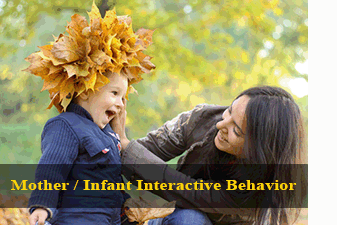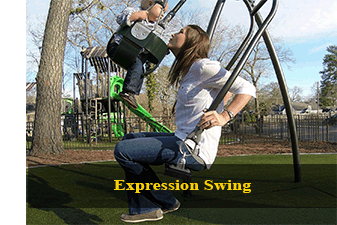|
|
How Play Environments Assist Mother / Infant Interactive Behavior
Author: Chad Kennedy, Landscape Architect, ASLA
 The process by which a child enters the world is a truly fathomless miracle. On three occasions I have personally witnessed this amazing process as a child gasps for its first breath, declares its first cry of dissatisfaction, and opens its eyes for the first time to gaze into its mother's eyes. Of all the crazy things that happen during the whirlwind of childbirth, the moments just mentioned create the most vivid and resonant memories. I stood by as an apparent bystander and watched as mother and child formed unique bonds through mutual gazing that perhaps none of us can truly understand or comprehend. As I watch my three children continue to grow and develop, I often notice this same mesmerizing gaze occur with their mother during moments of quiet calm, active play and even when miserable, cuddled close trying to fight off a cold. This interactive relationship, referred to as "Affect Attunement", developed between a mother and child, is real and seemingly palpable. This article will discuss the science behind this mother-child connection and offer examples of how the play environment can be altered to facilitate important mother-child interaction. The process by which a child enters the world is a truly fathomless miracle. On three occasions I have personally witnessed this amazing process as a child gasps for its first breath, declares its first cry of dissatisfaction, and opens its eyes for the first time to gaze into its mother's eyes. Of all the crazy things that happen during the whirlwind of childbirth, the moments just mentioned create the most vivid and resonant memories. I stood by as an apparent bystander and watched as mother and child formed unique bonds through mutual gazing that perhaps none of us can truly understand or comprehend. As I watch my three children continue to grow and develop, I often notice this same mesmerizing gaze occur with their mother during moments of quiet calm, active play and even when miserable, cuddled close trying to fight off a cold. This interactive relationship, referred to as "Affect Attunement", developed between a mother and child, is real and seemingly palpable. This article will discuss the science behind this mother-child connection and offer examples of how the play environment can be altered to facilitate important mother-child interaction.
The Science Behind Affect Attunement
During the first year or so of a child's life they develop from monitoring other's emotional experiences to a point where they can share emotional experiences with the world around them. The term "Affect Attunement" generally means the "sharing of emotional experiences through the matching of expressions during...face-to-face interaction between infants and caregivers."3 This occurs through all sensory modalities as a child but primarily developed through sustained gazing (sight),which has been shown to be the most "intense form of interpersonal communication." In fact, visual communication forms are used by children prior to vocal forms of shared communication.4 "Visual stimulation, embedded in mutual gaze transactions between caregiver and infant, is an essential component of a growth promoting environment. The mother's emotionally expressive face is the most potent source of visuoaffective information, and in face-to-face interactions it serves as a visual imprinting stimulus of the infant's developing nervous system." 4 On a similar note, other studies have shown strong correlations to proper childhood development for socio-cognitive capability, meaningful interpersonal communication, emphatic understanding, joint attention, and cultural learning.2,3
Unfortunately, "Affect Attunement" is not an innate process and must be instigated by a caring adult who makes an effort to be "attuned" with the child. In contrast, the reaction to the adult's effort, may actually be an innate biological mechanism related to the release of natural pleasure chemicals into the body following maternal-infant eye gaze and interaction. Some authors refer to this pleasure chemical as "parent juice".1 When a mother and child are gazing at each other, this "parent juice" actively engages the two in a connection between brains with the eyes as a physical link. When children feel a lack of this connection they check in by making eye contact with the mother, thus receiving a small rejuvenating dose of "parent juice."1 As suggested by research on the topic, it is wise for mothers to take advantage of any opportunity to engage in attunement with their child as often as the child is willing. This would include opportunities when the two are in an outdoor environment that may be distracting or not very conducive to one-on-one time.
Play Environments That Foster Gazing 
As a child grows they are progressively able to focus on objects at greater distances, but when they are young, the distance they can see is fairly limited. With this in mind, it is crucial that the mother be close to the child and at eye level with them. Most playgrounds are not designed for children and care-takers to play at eye level. So, how can this be facilitated? Below are a few ideas on how this can be accomplished:
- Elevation Change - Playgrounds that have elevation change and seat walls afford the opportunity for a mother to sit next to areas where the child is sitting or playing.
- Loose Materials - One of the most effective ways of promoting interactive play and engagement with facial expressions is play with loose materials. When play materials are loose they can be lifted to the face, shown to others, manipulated, and shared. Mothers can also fully engage in play with the child rather than simply monitoring them. Read more about loose play by clicking this link.
- Joint Swinging - Gametime, a Playcore Company and leader in play equipment manufacturing, has developed an innovative piece of equipment they call the "Expression Swing" (see the image above). This swing is carefully designed to promote gazing between mother and child. It allows the two individuals to safely swing face-to-face, in close proximity, and at eye level with each other. A traditional to-fro swing would require the child to separate from the mother each time the swing moves back and forth.
- Stepped Sand Play Areas - A series of elevated or stepped beds filled with sand or other friable material can be a great way to combine loose play and elevation change into a play environment. The child can sit and play in the higher sand bed while the mother sits next to or in the lower bed so the two are at eye level while they play in the sand, water, bark, etc.
- Toddler Tables - Playworld, Inc., another leader in play equipment manufacturing, has developed a picnic table that can also be utilized as an opportunity for mother and child to gaze at each other. The table is designed with a toddler chair (similar to a high chair) built into the table top in close proximity to the bench the mother would use to sit on. This is a passive rather than active opportunity for connection and attunement.
- Dramatic Play - Addition of dramatic play elements away from active play areas can help isolate attention and promote interaction. Dramatic play elements may include clear windows, small cabins, cozy spots and other close spaces meant for very small groups.
There are many opportunities in outdoor play environments to engage and connect with children at a deeper level. Utilization of these opportunities however, is contingent on a mother or other care-taker being willing to recognize and take advantage of opportunities around them, turning the environment into tools that help them connect. With exposure and a greater understanding of "Affect Attunement", maybe the next time we visit an outdoor play environment we will resist the urge to look at our phones, and spend some time searching for and recognizing ways to use that environment to recreate those endearing gazes I have watched my wife and children share.
To learn more about play related issues and other landscape architecture topics, please visit the publications section of our website by clicking here.
1-Cogen, Patty. Eye Contact Between Parents and Children: A Calming Connection Between Two Brains. http://www.pattycogenparenting.com/a-guide-to-articles/eye-contact-between-parents-and-children-a-calming-connection-between-two-brains/. Web. 27 APR. 2016.
2-Legerstee, Maria. Gabriela Markova and Tamara Fisher. The role of maternal affect attunement in dyadic and triadic communication. http://lchc.ucsd.edu/MCA/Mail/xmcamail.2010_01.dir/pdfc97xizhpyH.pdf Web. 27 APR. 2016.
3-Little, Emily. Infant-Caregiver Affect Attunement. https://carta.anthropogeny.org/moca/topics/infant-caregiver-affect-attunement Web. 27 APR. 2016.
4-Schore, Allan N. Affect Regulation and the Origin of the Self: The Neurobiology of Emotional Development. Psychology Press. New York. 2009
|
|
|
|
|
|
|
Funding Opportunities
Due date: May 20th, 2016
Outdoor Recreation Legacy Partnership Program The National Park Service State and Local Assistance Division announced the availability of $15 million (total) set aside in FY 2015 and FY 2016 appropriations for Land and Water Conservation Fund State Assistance grants for a nationally competitive grant program. Eligible U.S. state and local government agencies and federally recognized Indian tribes are invited to submit proposals for matching grants to support projects that would acquire or develop public land for outdoor recreation purposes located within or serving Census-delineated "urbanized areas": places with a population of 50,000 or more people that are densely settled... For additional information on this and other funding opportunities, please visit our Resource Center.
|
|
|
|
|
Media Updates
O'Dell Engineering's New Website! O'Dell Engineering has just published its new website. The new design is more intuitive, helpful, playful, and representative of the firm's expertise. Click here to take a look for yourself! O'Dell Engineering has just published its new website. The new design is more intuitive, helpful, playful, and representative of the firm's expertise. Click here to take a look for yourself!
|
|
|
|
|
Project Updates
Ceres Downtown Renovation Project, Ceres, CA
 The O'Dell Engineering landscape architecture and civil engineering team prepared a downtown renovation master plan for 4th street. Concepts included new traffic features, entry signage, street lighting, LID components, porous concrete, structural soil and supports for street trees and new parking configurations. The project is now in the construction document phase.
|
|
|
|
|
|
 The process by which a child enters the world is a truly fathomless miracle. On three occasions I have personally witnessed this amazing process as a child gasps for its first breath, declares its first cry of dissatisfaction, and opens its eyes for the first time to gaze into its mother's eyes. Of all the crazy things that happen during the whirlwind of childbirth, the moments just mentioned create the most vivid and resonant memories. I stood by as an apparent bystander and watched as mother and child formed unique bonds through mutual gazing that perhaps none of us can truly understand or comprehend. As I watch my three children continue to grow and develop, I often notice this same mesmerizing gaze occur with their mother during moments of quiet calm, active play and even when miserable, cuddled close trying to fight off a cold. This interactive relationship, referred to as "Affect Attunement", developed between a mother and child, is real and seemingly palpable. This article will discuss the science behind this mother-child connection and offer examples of how the play environment can be altered to facilitate important mother-child interaction.
The process by which a child enters the world is a truly fathomless miracle. On three occasions I have personally witnessed this amazing process as a child gasps for its first breath, declares its first cry of dissatisfaction, and opens its eyes for the first time to gaze into its mother's eyes. Of all the crazy things that happen during the whirlwind of childbirth, the moments just mentioned create the most vivid and resonant memories. I stood by as an apparent bystander and watched as mother and child formed unique bonds through mutual gazing that perhaps none of us can truly understand or comprehend. As I watch my three children continue to grow and develop, I often notice this same mesmerizing gaze occur with their mother during moments of quiet calm, active play and even when miserable, cuddled close trying to fight off a cold. This interactive relationship, referred to as "Affect Attunement", developed between a mother and child, is real and seemingly palpable. This article will discuss the science behind this mother-child connection and offer examples of how the play environment can be altered to facilitate important mother-child interaction.
 O'Dell Engineering has just published its new website. The new design is more intuitive, helpful, playful, and representative of the firm's expertise. Click
O'Dell Engineering has just published its new website. The new design is more intuitive, helpful, playful, and representative of the firm's expertise. Click 
